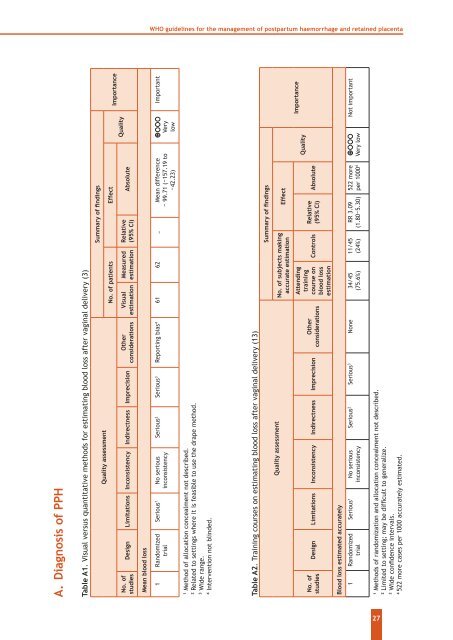WHO guidelines for the management of postpartum haemorrhage ...
WHO guidelines for the management of postpartum haemorrhage ...
WHO guidelines for the management of postpartum haemorrhage ...
Create successful ePaper yourself
Turn your PDF publications into a flip-book with our unique Google optimized e-Paper software.
<strong>WHO</strong> <strong>guidelines</strong> <strong>for</strong> <strong>the</strong> <strong>management</strong> <strong>of</strong> <strong>postpartum</strong> <strong>haemorrhage</strong> and retained placenta<br />
A. Diagnosis <strong>of</strong> PPH<br />
Table A1. Visual versus quantitative methods <strong>for</strong> estimating blood loss after vaginal delivery (3)<br />
No. <strong>of</strong><br />
studies<br />
Quality assessment<br />
Design Limitations Inconsistency Indirectness Imprecision<br />
O<strong>the</strong>r<br />
considerations<br />
Summary <strong>of</strong> findings<br />
No. <strong>of</strong> patients Effect<br />
Visual<br />
estimation<br />
Measured<br />
estimation<br />
Relative<br />
(95% CI)<br />
Absolute<br />
Quality<br />
Mean blood loss<br />
1 Randomized<br />
trial<br />
Serious 1 No serious<br />
inconsistency<br />
Serious 2 Serious 3 Reporting bias 4 61 62 – Mean difference<br />
– 99.71 (–157.19 to<br />
–42.23)<br />
Very<br />
low<br />
1<br />
Method <strong>of</strong> allocation concealment not described.<br />
2<br />
Related to settings where it is feasible to use <strong>the</strong> drape method.<br />
3<br />
Wide range.<br />
4<br />
Intervention not blinded.<br />
Table A2. Training courses on estimating blood loss after vaginal delivery (13)<br />
Quality assessment<br />
No. <strong>of</strong> subjects making<br />
accurate estimation<br />
Summary <strong>of</strong> findings<br />
Effect<br />
No. <strong>of</strong><br />
studies<br />
Design Limitations Inconsistency Indirectness Imprecision<br />
O<strong>the</strong>r<br />
considerations<br />
Attending<br />
training<br />
course on<br />
blood loss<br />
estimation<br />
Controls<br />
Relative<br />
(95% CI)<br />
Absolute<br />
Quality<br />
Blood loss estimated accurately<br />
1 Randomized<br />
trial<br />
Serious 1 No serious<br />
inconsistency<br />
Serious 2 Serious 3 None 34/45<br />
(75.6%)<br />
11/45<br />
(24%)<br />
RR 3.09<br />
(1.80–5.30)<br />
522 more<br />
per 1000 4 Very low<br />
1<br />
Methods <strong>of</strong> randomization and allocation concealment not described.<br />
2<br />
Limited to setting; may be difficult to generalize.<br />
3<br />
Wide confidence intervals.<br />
4<br />
522 more cases per 1000 accurately estimated.<br />
Importance<br />
Important<br />
Importance<br />
Not important<br />
27
















